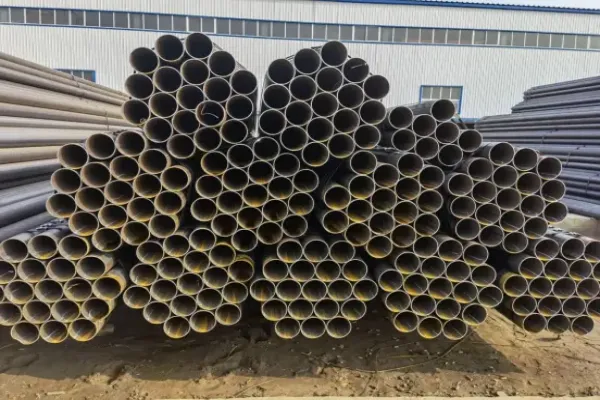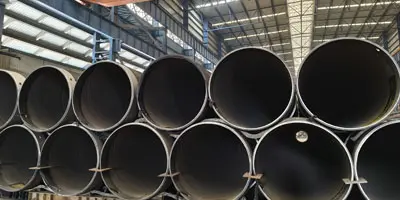Steel pipes are widely used in high, medium and low pressure fluid transportation pipelines such as oil, natural gas, water, steam, and coal gas, as well as steel pipes for
piling pipe, bridges, and buildings. Good quality steel pipes are convenient and beneficial to the people, but while steel pipes are developing rapidly, some counterfeit products will appear on the market one after another. So how to judge the quality of steel pipes?
First, we need to measure the diameter, wall thickness, length and appearance of the steel pipe to see if they meet the standards. Counterfeit steel pipes often have pitting on the surface, and the material is poor, the end face of the cut head is uneven, there is no metallic luster, the inner diameter size fluctuates greatly, and it is easy to scratch and reduce the strength of the steel. Huayang Steel Pipe adopts high-frequency resistance welding and ERW technology, which runs through the entire link from steel plate to steel pipe to realize automated production. High-quality and high-strength steel pipes are guaranteed, with good surface quality and superior performance.
Secondly, do water pressure tests and ultrasonic flaw detection to see if they are qualified. The water pressure test is to ensure that the steel pipe can withstand a large enough pressure during use to avoid safety hazards. Online ultrasonic flaw detection is used to detect the welding of the weld to prevent the steel pipe from having problems such as pores and inclusions. Compared with many steel pipe factories on the market that rely on manual flaw detection, Baowi Steel Pipe's online flaw detection equipment is advanced, and while ensuring quality, it greatly improves production efficiency.
In addition, we need to do mechanical property experiments and chemical analysis. For example, the surface quality of the steel pipe, the excess height of the weld, the roundness of the pipe, etc.,
Baowi Steel will carefully test them one by one to see if the results meet the standards. There are different standards for steel pipes in different fields. When unqualified steel pipes are detected, they are repaired according to the standards. If they cannot be repaired, the steel pipes are downgraded or scrapped. Strictly follow the requirements to ensure the quality of the steel pipes. They will be delivered to customers only after passing the inspection layer by layer. Unqualified ones will never leave the factory! !

Some methods to check the quality of steel pipes
1. Visual inspection: Check whether the pipe has any visible defects, such as cracks, dents or surface irregularities. Check whether the color, texture and surface finish are uniform.
2. Dimensional Check: Use a caliper or measuring tape to measure the outside diameter (OD), inside diameter (ID), and wall thickness of the pipe. Compare the measurements to the specified dimensions to ensure they meet the required standards.
3. Material Composition: Verify the material composition of the steel pipe by checking the grade or specification indicated by the manufacturer. This can be done by referencing the relevant industry standards or consulting the manufacturer's documentation.
4. Weight and Length: Weigh the pipe using a scale to ensure it meets the specified weight. Measure the length of the pipe to confirm it meets the required dimensions.
5. Magnetic Inspection: Use magnetic particle inspection (MPI) or magnetic flux leakage (MFL) testing to detect surface or subsurface defects in the pipe. This method is particularly useful for identifying cracks or discontinuities.
6. Nondestructive Testing (NDT): Perform other nondestructive tests such as ultrasonic testing (UT), radiographic testing (RT), or eddy current testing (ECT) to evaluate the integrity and soundness of the steel pipe. These tests can identify internal defects such as cracks or voids.
Nondestructive testing is an important means of judging the quality of steel pipes. Through nondestructive testing methods such as radiographic testing (RT), magnetic particle testing (MT), penetrant testing (PT), ultrasonic testing (UT) or eddy current testing (ET) on steel pipes, it is possible to check whether there are defects such as cracks, inclusions, pores, etc. inside the steel pipe. These defects will seriously affect the performance and safety of the steel pipe, so strict nondestructive testing must be carried out. When conducting nondestructive testing, it is necessary to select appropriate testing methods and equipment to ensure the accuracy and reliability of the test results. In addition to the above inspections, attention should also be paid to the production process and quality control of the steel pipe. High-quality steel pipes are usually manufactured using advanced production processes and equipment and undergo strict quality control processes.
7. Pressure test: Perform a hydrostatic pressure test to inject water or other suitable fluids into the pipe and apply pressure to check for leaks or defects. The pressure applied should be higher than the maximum working pressure of the intended application.
8. Certification and compliance: Verify that the steel pipe has the necessary certifications and complies with relevant industry standards, such as ASTM, API or ISO. These certifications ensure that the pipe meets the required quality and performance standards.






 English
English Español
Español بالعربية
بالعربية











 Phone :
Phone :  Whatsapp :
Whatsapp :  Email :
Email : 


